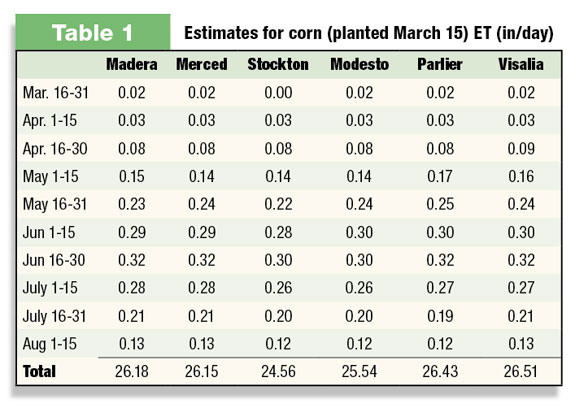As the crop takes up water from the soil in its root zone, irrigation is required periodically to replace that water. Soil water-holding capacity, influenced by soil type, and rooting depth of the crop, impact how often irrigation needs to occur (irrigation frequency). Many growers have a sense of how long they can go between irrigations before the crop shows signs of stress, but often by the time the crop shows stress, it has already lost yield.
Using soil moisture monitoring tools, such as soil moisture blocks, can provide valuable information on the amount of soil moisture in the crop’s root zone, allowing you to anticipate when it will be time to irrigate.
Estimating the crop water use between irrigations gives a good estimate of the amount of irrigation water needed to replenish the soil water in the crop’s root zone. Water use by a crop is often referred to as its evapotranspiration (ET). ET combines the evaporation from the soil with transpiration of the crop. ET tables are available on the Internet in various locations, or see the example provided in Table 1. The ET values in this tables are in units of inches of water use per day during the calendar periods shown in the left-hand column.

For example, for corn planted March 15 in Merced, California, the ET is 0.29 inches per day during the June 1 to 15 period. In other words, for each day during the June 1 to 15 period, the corn crop would be using 0.29 inches per day of water. ET estimates provided are historical averages. Actual daily crop water use may vary from these averages, but over a time period of a week or more, the averages are quite accurate.
To determine the irrigation amount needed to replace the soil water used by the crop, simply add up the daily values since the last irrigation. For example, for corn planted March 15 in Merced, if the last irrigation was June 1 and the next is 10 days later, the crop ET would be 2.9 inches (10 days x 0.29 inches per day = 2.9 inches). You would want to replace 2.9 inches of soil moisture with your irrigation.
Early season crop water use is low and increases to a maximum in June and July, periods of high heat and long daylight hours. Lower ET, early in the season, results from cooler weather and shorter days as well as from a crop canopy (for annual crops) that is developing. The early season, low ET, would seem to indicate that you could go a long time between irrigation, but for annual crops the early season root zone is still developing and irrigations should still be relatively frequent but of a lesser amount. FG
—Excerpts from University of California Dairy Newsletter, January 2010










